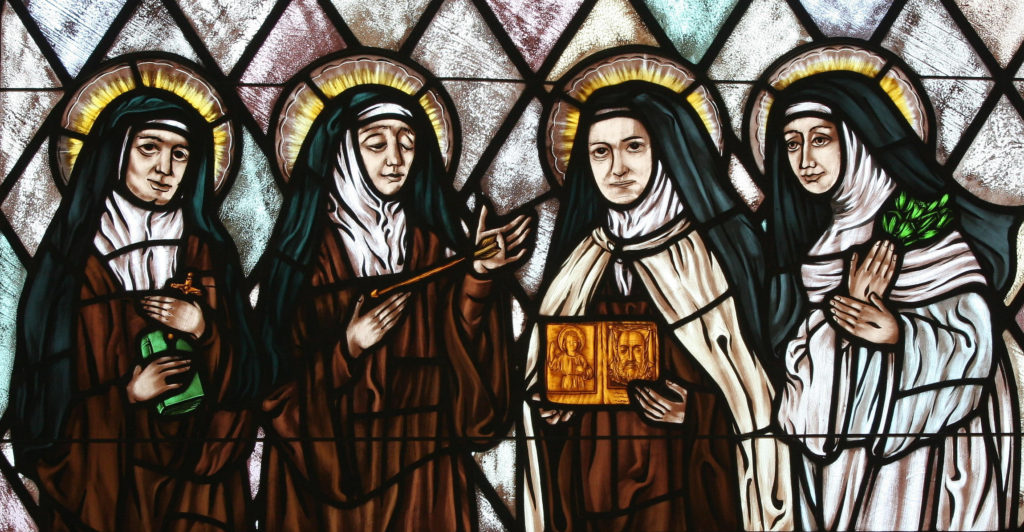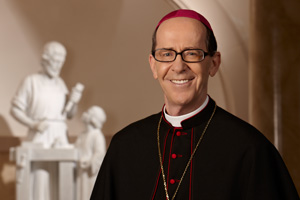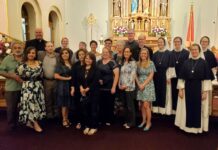

St. Teresa Benedicta of the Cross
Eighth in a series
[dropcap type=”4″]S[/dropcap]he was the youngest of eleven children in a Jewish family in Breslau (now Wroclaw, Poland), a brilliant young scholar who stopped believing in God at age 14, earned her doctorate in philosophy by age 24 and converted to Christianity at age 31. Several years thereafter, she became a Carmelite nun and at age 50 was a victim of Nazi totalitarianism, dying in a gas chamber in Auschwitz on Aug. 9, 1943.

For many good reasons, Edith Stein is remembered and honored today, perhaps none being more significant than her constant quest for truth and love.
Three women greatly impacted her life: one whose husband was her academic colleague and friend, one whose name is unknown and the third a Spanish nun who lived four centuries before her.
The widow’s peace
Edith’s colleague at the University of Freiburg, Adolf Reinach, was killed during World War I on Flanders’ fields. His death left Edith deeply distraught and disoriented: she had admired this fellow scholar’s goodness, appreciated his kindness, and was attracted by his Christian faith even if she was not yet able to make it her own. Without faith herself, she was at a loss as to how to deal with Reinach’s death and how to comfort his widow. With considerable hesitation, she traveled to the Reinach home where, to her surprise, she met a woman unlike any she had ever met before. In her biography of Edith Stein, Waltraud Herbstrith describes the encounter in this way, “Rather than appearing crushed by her suffering, the young widow was filled with hope that offered the other mourners consolation and peace. Edith Stein’s rational arguments crumbled in the face of this experience. Not the anticipated intellectual insight, but contact with the essence of truth itself transformed her. The light of faith broke in on her — in the mystery of the Cross.”
Twenty years later, Edith would tell a priest friend, “It was my first encounter with the Cross and the divine power that it bestows on those who carry it. For the first time, I was seeing with my very eyes the Church, born from her Redeemer’s sufferings, triumphant over the sting of death. That was the moment my unbelief collapsed and Christ shone forth…”
The anonymous woman
Not long after this meeting with Mrs. Reinach, as Edith was inching closer to the gifts of Baptism and faith, a friend took her to see the cathedral in Frankfurt. This is how Edith described what happened, “We went into the cathedral for a few moments, and as we stood there in respectful silence, a woman came in with her shopping basket and knelt down in one of the pews to say a short prayer. This was something completely new to me. In the synagogue, as in Protestant churches I had visited, people only went in at the time of the service. But here was someone coming into the empty church in the middle of a day’s work as if to talk with a friend. I have never been able to forget that.”
An anonymous woman’s visit to the Blessed Sacrament, which she probably did on a routine basis, stirred within Edith’s heart a great longing for a similar intimacy with God, for an encounter that went beyond philosophical concepts, one that combined truth with love. If this anonymous woman could be so absorbed in prayer with God, just seconds after leaving behind the noisy turmoil of the city outside, then could she not hope for the same?
The witness of a Spanish nun
Seemingly by chance, in 1921, Edith Stein came across the autobiography of Teresa of Avila. After only the first few pages, she was captivated and spent a whole night absorbing it like a sponge. In the morning, she realized that she had a new friend, who may have lived hundreds of years before but whose love of God was as fresh as spring rain.
Edith Stein learned that God had planted in Teresa’s heart what she had recently discovered in her own, namely a desire for a close and loving friendship with Him. To enter into this love, to make it her own and to continue to grow in it, St. Teresa taught Edith how to overcome a roadblock, namely her own self-reliance. St. Teresa writes: “I give you one counsel; that you don’t think that through your own strength or efforts you can arrive, for reaching this stage is beyond your power; if you try to reach it, the devotion you have will grow cold. But with simplicity and humility, which will achieve everything, say…‘Lord, your will be done’.” After years of searching for God, Edith was now ready to surrender.
The Abundance of God’s love
From the day of her Baptism on, Edith’s heart overflowed with the joy of the Gospel. She was overwhelmed with the Lord’s goodness to her and began at once to share God’s gifts with others. She accepted a position at a Dominican Sisters School, where she taught German for the next eight years. In addition, she helped the less fortunate, distributing food and doing counseling. She also spent long hours at night before the Blessed Sacrament.
Every part of her longed to take the path set forth by Teresa of Avila, i.e. to become a Carmelite nun. But there was one thing that held her back for several years: a fourth woman, someone very dear to her — her own Jewish mother. Mrs. Stein could not understand Edith’s conversion to Christ, and she could not agree with it, let alone accept her daughter’s desire to enter Carmel. How could a loving daughter abandon her 84-year old mother just when Jews in Germany were facing increasingly bitter persecution? Edith’s mother painfully struggled with this question and so did this devoted daughter. But the Bridegroom kept calling His bride. The vocation to Carmel grew stronger day by day. Eventually, Edith knew that she could delay no longer her eager “Yes” to the call of Christ. Reflecting back on the day that she bid farewell to her grieving mother, Edith wrote, a few years later, “I couldn’t feel any violent upsurge of enthusiasm over it: I had just been through something too terrible for that. But I did feel a great sense of calm, knowing that I was coming into the harbor of God’s will.”
Edith, with her new name Sister Teresa Benedicta of the Cross, patiently carried in her heart this personal sorrow of her mother’s opposition; at the same time, she had no doubt that Carmel was truly God’s will, and that her obedience was good not only for her but also for her mother and the entire family.
Her adjustment to Carmelite life was remarkably smooth and her spirit was flooded with consolations. The continuing opposition of her mother, however, never lessened: she would not answer Edith’s weekly letters; she refused to attend the clothing ceremony beginning novitiate; she considered her daughter completely cut off from the Jewish people (despite Edith’s insistence that she was even more closely united with them now).
Edith, with her new name Sister Teresa Benedicta of the Cross, patiently carried in her heart this personal sorrow of her mother’s opposition; at the same time, she had no doubt that Carmel was truly God’s will, and that her obedience was good not only for her but also for her mother and the entire family. She wrote: “The bride of Christ assumes a life of spiritual motherhood for all redeemed humanity. This is just as true whether she works directly with souls or whether, by sacrifice alone, she brings forth fruit hidden from both herself and from everyone else.”
We learn from St. Teresa Benedicta of the Cross how God speaks to us through the faithful witness of others and how he is at work even when we don’t understand. At the homily on the day of her canonization, Pope St. John Paul II gave this advice, “Do not stay on the surface but go to the heart of things! And when the time is right, have the courage to decide! The Lord is waiting for you to put your freedom in His good hands.”





![[VIDEO] Make Sunday feel like Sunday again](https://www.catholicsun.org/wp-content/uploads/2021/04/2021-YOUTUBE-BISHOP-MESSAGE-THUMBNAIL-ENGLISH-218x150.png)